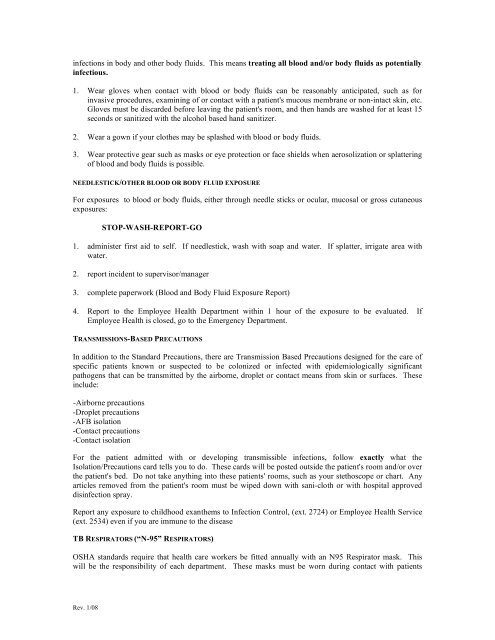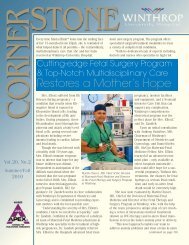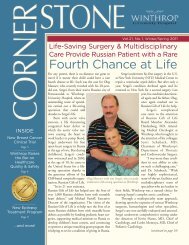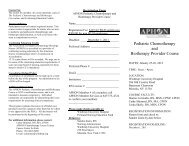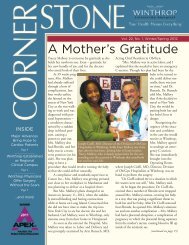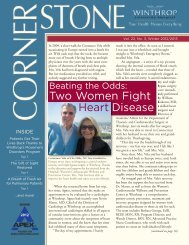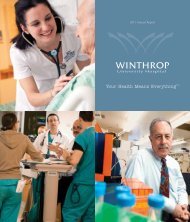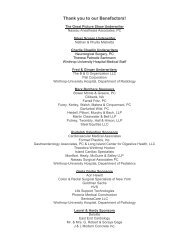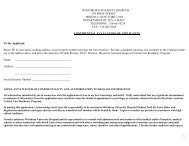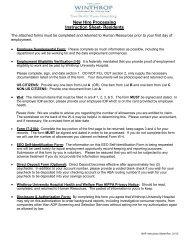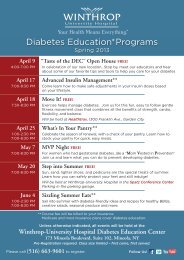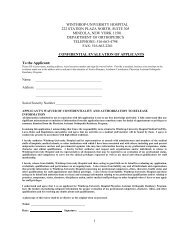House Staff Manual - Winthrop University Hospital
House Staff Manual - Winthrop University Hospital
House Staff Manual - Winthrop University Hospital
You also want an ePaper? Increase the reach of your titles
YUMPU automatically turns print PDFs into web optimized ePapers that Google loves.
infections in body and other body fluids. This means treating all blood and/or body fluids as potentiallyinfectious.1. Wear gloves when contact with blood or body fluids can be reasonably anticipated, such as forinvasive procedures, examining of or contact with a patient's mucous membrane or non-intact skin, etc.Gloves must be discarded before leaving the patient's room, and then hands are washed for at least 15seconds or sanitized with the alcohol based hand sanitizer.2. Wear a gown if your clothes may be splashed with blood or body fluids.3. Wear protective gear such as masks or eye protection or face shields when aerosolization or splatteringof blood and body fluids is possible.NEEDLESTICK/OTHER BLOOD OR BODY FLUID EXPOSUREFor exposures to blood or body fluids, either through needle sticks or ocular, mucosal or gross cutaneousexposures:STOP-WASH-REPORT-GO1. administer first aid to self. If needlestick, wash with soap and water. If splatter, irrigate area withwater.2. report incident to supervisor/manager3. complete paperwork (Blood and Body Fluid Exposure Report)4. Report to the Employee Health Department within 1 hour of the exposure to be evaluated. IfEmployee Health is closed, go to the Emergency Department.TRANSMISSIONS-BASED PRECAUTIONSIn addition to the Standard Precautions, there are Transmission Based Precautions designed for the care ofspecific patients known or suspected to be colonized or infected with epidemiologically significantpathogens that can be transmitted by the airborne, droplet or contact means from skin or surfaces. Theseinclude:-Airborne precautions-Droplet precautions-AFB isolation-Contact precautions-Contact isolationFor the patient admitted with or developing transmissible infections, follow exactly what theIsolation/Precautions card tells you to do. These cards will be posted outside the patient's room and/or overthe patient's bed. Do not take anything into these patients' rooms, such as your stethoscope or chart. Anyarticles removed from the patient's room must be wiped down with sani-cloth or with hospital approveddisinfection spray.Report any exposure to childhood exanthems to Infection Control, (ext. 2724) or Employee Health Service(ext. 2534) even if you are immune to the diseaseTB RESPIRATORS (“N-95” RESPIRATORS)OSHA standards require that health care workers be fitted annually with an N95 Respirator mask. Thiswill be the responsibility of each department. These masks must be worn during contact with patientsRev. 1/08


